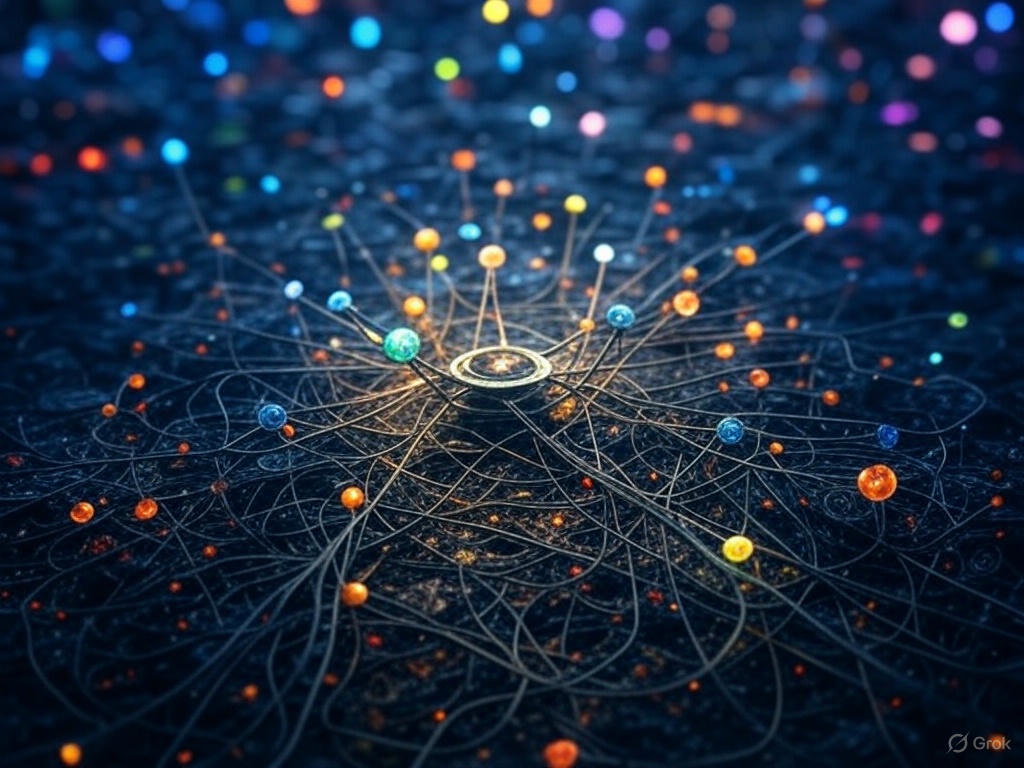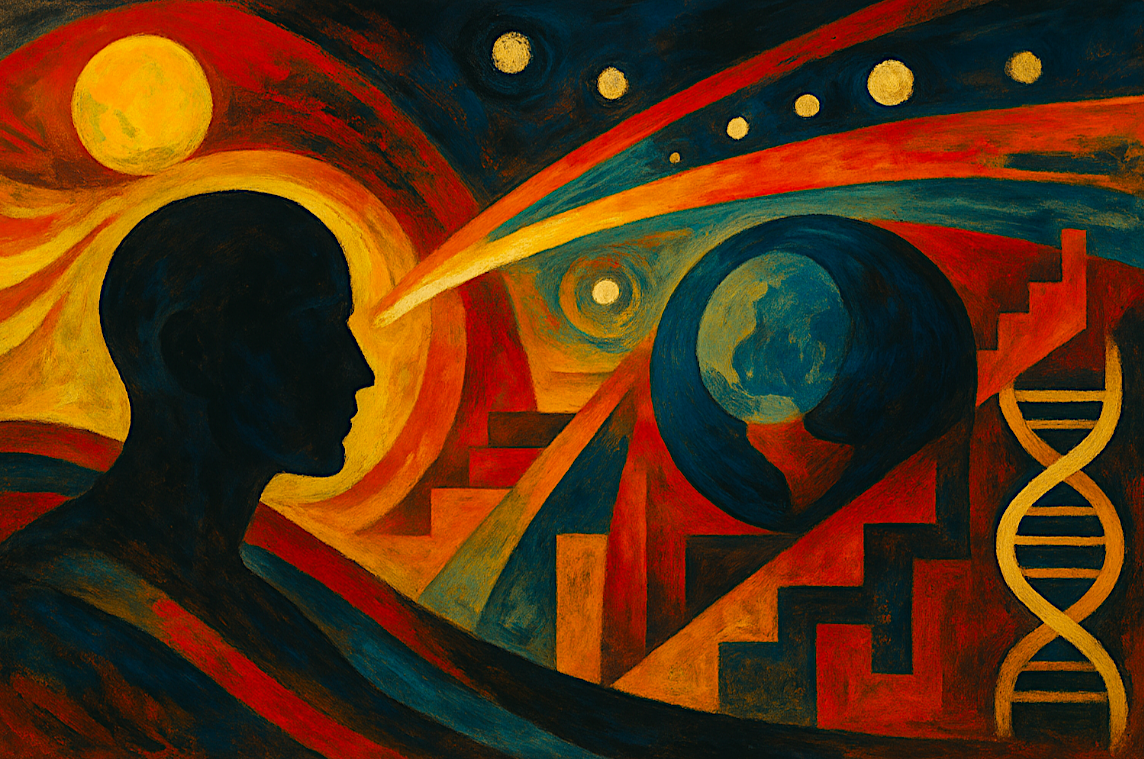Quantum Hypergraph Networks

Okuhle Madondo
January 24, 2025

The world of computation is a fascinating place, where ideas like hypergraphs, neural networks, and quantum mechanics can collide to spark something entirely new. Lately, I’ve been flirting the concept of Quantum Hypergraph Networks (QHNs)—a speculative blend of hypergraph theory, machine learning, and quantum computing that feels like it could push the boundaries of what’s possible. It’s not a fully formed technology yet, more of a tantalizing “what if,” but the thought of digging into it someday, maybe when quantum hardware catches up, has me quietly hooked. In this essay, I’ll unpack what QHNs might be, how they could work, and where they might make a difference, tossing in some rough math on how much faster they could run compared to what we’ve got now.
Hypergraphs are a good starting point. Unlike regular graphs, where an edge links just two nodes—say, a line between two friends—a hypergraph’s hyperedge can tie together a whole group, like a study circle of five people. It’s a natural way to model complex systems where interactions aren’t just one-on-one. I came across this idea in Stephen Wolfram’s Physics Project, which imagines the universe as a massive hypergraph where particles, like electrons or photons, might be stable patterns that ripple through its evolving structure. That’s kinda crazy tbh—reality itself as a kind of network. In computing, hypergraphs already help us tackle things like social dynamics or chemical reactions, capturing relationships that pairwise graphs miss.
Now, imagine layering neural networks onto that. Hypergraph Neural Networks (HGNNs) are like graph neural networks but built for groups. Picture nodes—like people in a social network—each with features, maybe their interests or habits. These nodes send their data to hyperedges, which act like shared spaces, maybe a group chat or a team project. The hyperedge collects and processes that info, then sends back updated insights to its nodes, refining their features to reflect the group’s influence. It’s a back-and-forth, processed through neural layers, that produces embeddings—compressed representations of nodes or hyperedges—for tasks like predicting who’ll join a club or how a molecule might react. The magic here is how HGNNs embrace group dynamics, making them more expressive than standard graph models for messy, multi-way data.
The catch is that HGNNs can grind to a halt on big datasets. Training them involves heavy computation, sometimes scaling quadratically or worse with the number of nodes or hyperedges. That’s where quantum computing sneaks into the picture, and it’s why I’m kind of curious about QHNs. A QHN would take the HGNN idea—group-aware learning—and run it on a quantum computer, tapping into quirks like superposition, where multiple states are explored at once, or entanglement, which could mirror group connections in a spooky, quantum way. It’s not a real thing yet, just a concept floating around ideas like quantum graph neural networks or hypergraph-based physics, but it feels like a puzzle worth poking at eventually.
How would a QHN even work? It’d likely build on HGNN mechanics but go quantum. In an HGNN, the math involves aggregating node features into hyperedges—say, averaging them—and updating nodes based on that. A QHN might encode those features as quantum states, letting superposition crunch many hyperedge configurations simultaneously. Optimization could lean on quantum algorithms, like Grover’s search, which speeds up unstructured searches from to . The result? Faster training, richer embeddings, and maybe a knack for problems classical systems struggle with. I’m not saying I’d drop everything to study this now—quantum computers today are too noisy—but when fault-tolerant ones show up, I could see myself tinkering with QHN algorithms.
So, where could QHNs make a splash? One spot is physics, especially ideas like Wolfram’s, where hypergraphs might describe the universe. A QHN could simulate multi-particle systems, with hyperedges standing in for entangled states. Classically, modeling particles can take time—exponential and brutal. A quantum approach might cut that to something like , potentially thousands of times faster for, say, 30 particles. That could mean probing quantum gravity or spacetime in seconds, not years, which is the kind of thing that makes you pause and wonder.
Chemistry’s another big one. Molecules have multi-atom interactions—perfect for hyperedges—and quantum computers are already good at simulating quantum systems. A QHN could model a molecule with 10,000 atoms, where classical methods might need steps. Quantum tricks could drop that to , maybe a 100- to 1000-fold speedup. Imagine designing a new drug or superconductor in minutes instead of months—it’s hard not to get a little excited about that.
Optimization problems, like splitting a hypergraph into efficient chunks for logistics, could also benefit. These are often NP-hard, with classical solutions scaling linearly or worse, say for variables. A QHN using something like the Quantum Approximate Optimization Algorithm might hit , offering a 100x boost for a million-variable problem—think streamlining supply chains in hours, not days.
In AI, QHNs could supercharge tasks like recommendation systems or biological modeling. Training an HGNN on a 10-million-node dataset—say, a social network with group interactions—can take days. A QHN, especially on future hardware, might slash that to hours, maybe a 1000x gain, by parallelizing feature updates in quantum states. It could mean spotting disease patterns or personalizing ads with eerie precision.
Social networks are a natural fit too. Hyperedges can represent communities, and a QHN could track their evolution—say, predicting viral trends on a 100,000-user platform. Classical analysis might scale linearly, but quantum methods could cut that time by 100x to 1000x, letting you forecast a hit hours before it blows up.
Security’s another angle. Hypergraphs could model multi-party protocols, like secure voting systems. Quantum algorithms might analyze keys 100x faster than classical ones, say by reducing to , which could either strengthen or shake up cryptography—both intriguing prospects.
In biology, QHNs could simulate brains or ecosystems, with hyperedges as neural circuits or food webs. Modeling a million neurons classically is a slog, but a QHN might hit 1000x speedups, turning decades into hours. That’s a step toward understanding cognition or saving endangered systems.
Economics rounds it out—think multi-player games where hyperedges are coalitions. Finding stable outcomes classically can be slow, but a QHN might cut to , a 100x gain for 1000 players, enabling real-time fixes for markets or policies.
QHNs aren’t here yet—they’d need better quantum computers, sharper math, and a lot of elbow grease. Today’s noisy machines might eke out 10x gains; future ones could hit 1000x or more for the right problems. They’re not a fix-all, but where group dynamics and quantum weirdness meet, they could be a quiet revolution. I’m intrigued enough to imagine exploring them down the line, maybe coding a few quantum convolutions to see what clicks. For now, it’s a spark—an idea that computation might one day weave physics, life, and society into something new.
Continue Reading
The Nature Of Nature
March 25, 2025
What separates a smartphone from a spiderweb? One’s a gleaming gadget, the other a sticky trap—yet both come from creatures shaped by this planet. We label one 'artificial' and the other 'natural,' but what if that line’s blurrier than we think?
The Cold Light
March 2, 2025
A flicker of light pierced our ancient shadows. Now, poised on an unseen edge, humanity faces a veiled choice—ascend or fade. The stars hold their silence.

